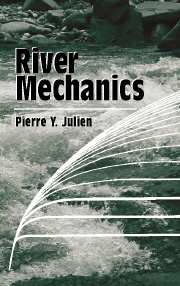Book contents
- Frontmatter
- Contents
- Preface
- Notation
- 1 Introduction to river mechanics
- 2 Physical properties and equations
- 3 River basins
- 4 Steady flow in rivers
- 5 Unsteady flow in rivers
- 6 River equilibrium
- 7 River dynamics
- 8 River stabilization
- 9 River engineering
- 10 Physical river models
- 11 Mathematical river models
- 12 Waves and tides in river estuaries
- Bibliography
- Index
2 - Physical properties and equations
Published online by Cambridge University Press: 05 June 2012
- Frontmatter
- Contents
- Preface
- Notation
- 1 Introduction to river mechanics
- 2 Physical properties and equations
- 3 River basins
- 4 Steady flow in rivers
- 5 Unsteady flow in rivers
- 6 River equilibrium
- 7 River dynamics
- 8 River stabilization
- 9 River engineering
- 10 Physical river models
- 11 Mathematical river models
- 12 Waves and tides in river estuaries
- Bibliography
- Index
Summary
As a natural science, the variability of river processes must be examined through the measurement of physical parameters. This chapter first describes dimensions and units (Section 2.1), physical properties of water (Section 2.2), and sediment (Section 2.3). The equations governing the motion of water and sediment from upland areas to oceans include kinematics of flow (Section 2.4), the equation of continuity (Section 2.5), the equation of motion (Section 2.6), and the concept of hydraulic and energy grade lines (Section 2.7). In this chapter and in the rest of the book, a solid diamond (♦) denotes equations and problems of particular significance. Problems with a double diamond (♦♦) are considered most important.
Dimensions and units
Physical properties are usually expressed in terms of the following fundamental dimensions: mass (M), length (L), time (T), and temperature (T°). Throughout the text, the unit of mass is preferred to the corresponding unit of force. The fundamental dimensions are measurable parameters that can be quantified in fundamental units.
In the SI system of units, the fundamental units of mass, length, time, and temperature are the kilogram (kg), the meter (m), the second (s), and degrees Kelvin (°K). Alternatively, the Celsius scale (°C) is commonly preferred because it refers to the freezing point of water at 0°C and the boiling point at 100°C.
A Newton (N) is defined as the force required for accelerating 1 kg at 1 m/s2.
- Type
- Chapter
- Information
- River Mechanics , pp. 9 - 30Publisher: Cambridge University PressPrint publication year: 2002



